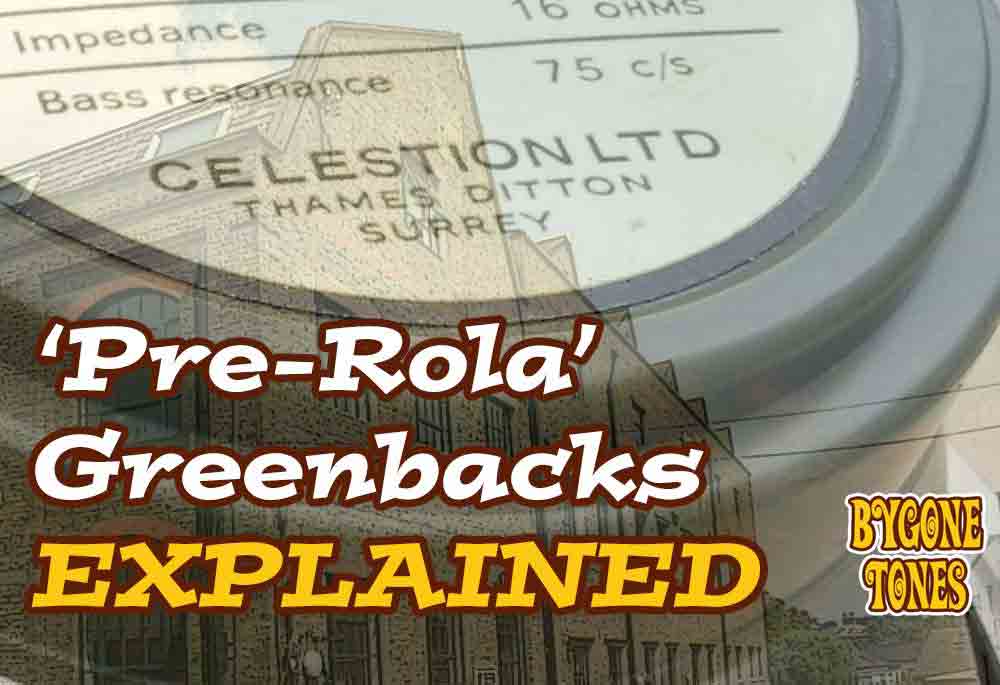
Pre-rola greenbacks are considered to be some of the best sounding guitar speakers ever made. They are highly collectable due to their association with 1960’s amplifiers, notably Marshall, and the guitar legends that used them back in the day.
However, there is a lot of confusion about what the term pre-rola actually means, and how we define a speaker as being a pre-rola.
A common misconception debunked
Pre-rola is not a reference to the history of the company – a time when Celestion were “not Rola”.
‘Rola Celestion Ltd’ was formed way back in 1947, as a result of ‘British Rola Ltd’ merging with ‘Celestion Ltd’. This was way before any greenback speakers or Celestion branded guitar speakers were ever made.

So what is a pre-Rola?
A pre-rola speaker is any Celestion greenback made between roughly Jan 1966 and April 1971, with the ‘Celestion Ltd, Thames Ditton Surrey’ text at the bottom of the label.
Guitarists call them ‘pre-rola’ because they came before the labels with the ‘Rola Ipswich’ text on them.
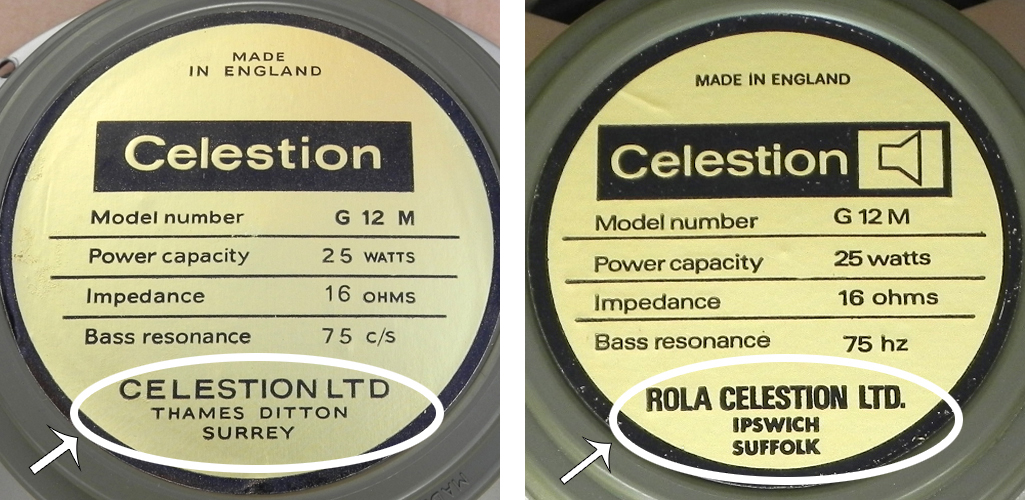
The Ipswich Suffolk address is important to note on the 1970’s Rola labels, for reasons I will get to a bit further down the page.
Transition Dates
The Rola Ipswich labels first appeared in April 1971, so any speakers made after April 1971 are generally not classed as pre-rola.
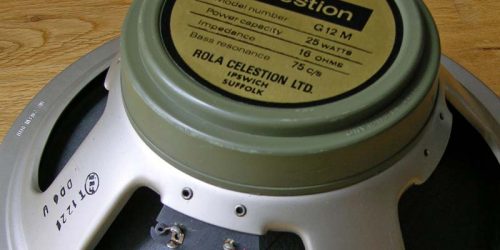
Both the Rola Ipswich and pre-rola labels can be found on speakers from April 71 with the DD date code on the frame leg. This was the transitional month for the labels.
After April 1971
Celestion did not change the labels across all speaker models at the same time, it was a gradual transition. Speaker models produced in lower numbers, such as the 8 Ohm models, often transitioned a bit later, some as late as 1975.

Most collectors will not class a speaker made after April 71 as being a true pre-rola even if it has the pre-rola label on it.
According to Celestion’s history, they were producing speakers at both the Thames Ditton factory and the Ipswich factory from late 1968 to late 1975, so if you think about it, there was no need to stop using the Thames Ditton labels at that time. Maybe the 8 ohm speakers were still being made at Thames Ditton? Who knows.
Before 1966
Before the pre-rola labels, Celestion were using gold and red foil labels. Notice the Thames Ditton address, rather than the Ipswich Suffolk address:
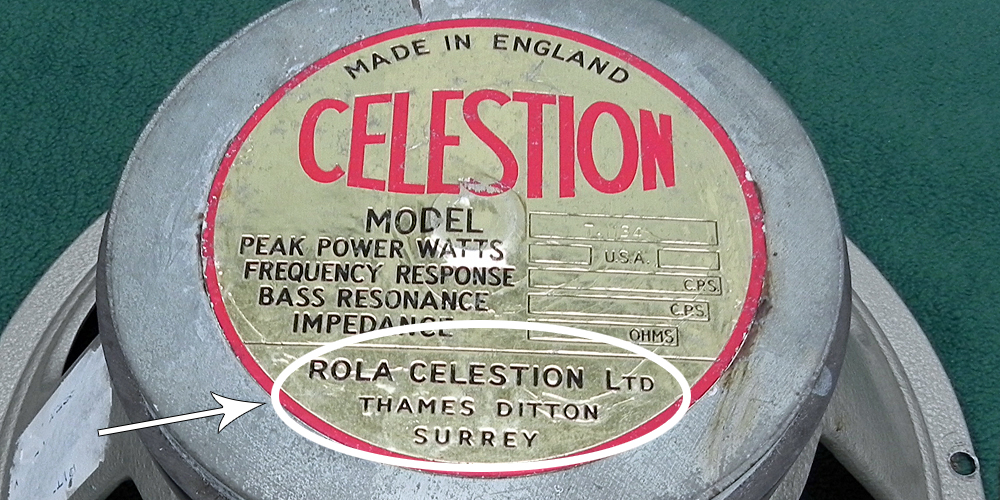
Speakers with these gold and red labels are very rare to find these days. They were only used for a short period circa 1964 to early 1966, and found on the first ever greenbacks – before they were green. Very collectable!
Why do pre-rolas sound better than other greenbacks?
During the whole pre-rola period Celestion were using cones made by a company called ‘Pulsonic’. These are generally considered to be the best sounding guitar speaker cones ever made.
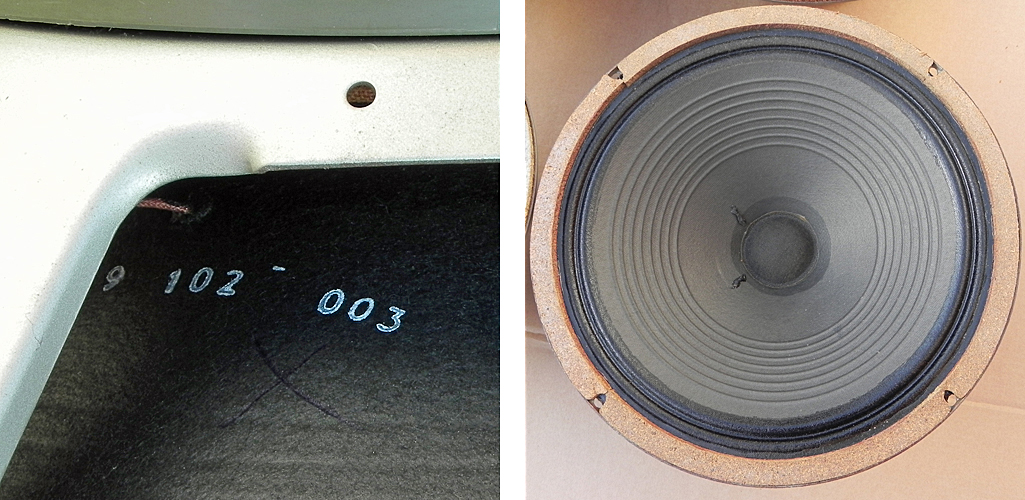
Legend has it that due to a fire at the factory in late 73 those amazing sounding cones were never made again. Nobody has replicated them successfully since, though several boutique brands have attempted it, including Celestion themselves.
The good news is that you do not have to pay pre-rola collector prices to get the Pulsonic sound. Pulsonic cones were actually used by Celestion from mid 1962 to late 1973 – well into Rola Ipswich label period. You might also find the ‘large rib’ pulsonic cones on some creamback speakers made from mid 1974 to mid 1975. These later speakers are less collectable and usually a little cheaper to buy, but will sound just as good.
Where to hear them
I recommend listening to any live recordings made between 1966 and 1971 by Jimi Hendrix, Cream (Eric Clapton), Deep Purple (Ritchie Blackmore), Free (Paul Kossoff), and Led Zeppelin (Jimmy Page). This should give you a good grounding in the Celestion pre-rola sound.
Youtube has lots of great footage. Free at the Isle Of Wight in 1970 is a good starting point – Kossoff’s tone was something else.
Clones and Reissues
Buying vintage pre-rola greenbacks can be difficult. Their rarity is part of their appeal to collectors, and when you do finally find a good set without any faults, they can be very expensive to buy.
There are several speaker brands that now manufacture their own pre-rola ‘clones’. All attempting to recreate the old 60’s British sound. The brands most worthy of trying out are Austin Speaker Works (ASW), Tayden, Eminence, Warehouse Guitar Speakers (WGS), and the Weber Legacy series.
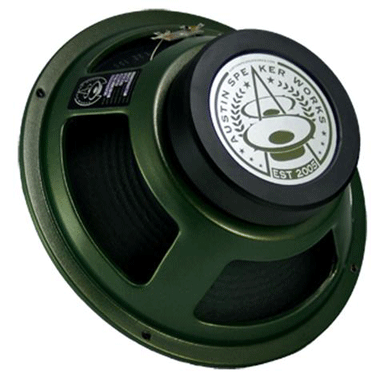
Let’s not forget that Celestion themselves are still making great speakers. As I always say, if you want the Celestion sound, stick with Celestion!
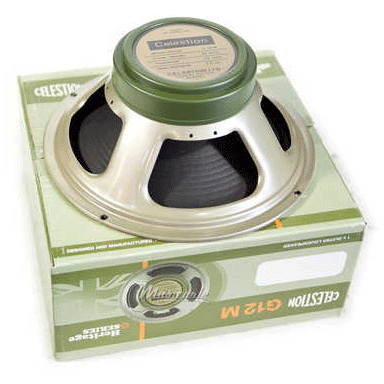
For a good tonal comparison with some modern day greenbacks I can highly recommend this video made by George Metropoulos. Although there are many similar videos on youtube these days I still think this recording captures their sound the most accurately and professionally:
In my opinion the reissues and clones will get you about 80% there, but the genuine vintage speakers still sound superior. The main problem modern speaker manufacturers face is that the old materials, tools and glues are no longer available, and it is those little details combined that created the magic in those old cones.

I have plenty of rose tinted spectacles with a green back if anyone needs them. Just $450 a pair…
Perfect😂
Roy, RMJ Loudspeakers.
I still have some pulsonic cones left, similar price to your Glasses😊
Do the frames have a smooth or a hammertone finish?
Author
Hi, sorry for late reply. It depends on the speaker model. Most guitar speakers (T1221, T1217 etc) had the smooth paint finish as standard until around October 1972, then they changed to the hammered paint finish. However some speaker models such as T1134 and T0731 came with the hammered paint finish as standard.
Hope that helps, Brian.
Great article ! Thanks 🙂 I could weep now from all the many Green backs I sold 30 years ago … Still chasing the sound 🙂 I had a really large collection of Marshall 4 x12’s.. and amps
Author
Hi Andrew, glad you liked the article. It is never too late to build up that collection again 😉
regards, Brian.
(2021) Yes, I have begun collecting again, the sound is a kind of addiction I guess. For some reason they just sound so much better, until you actually compare them yourself it is difficult to understand for most folk. I worked with guitarists who were chasing the “sound” for years and never ever found it… I was lucky enough to have found it, lost it then found it again… for keeps ! The interesting thing I find is that these older speakers make almost any tube amp sound amazing, although I generally use them with a Marshall 50 MV combo, an Engl 50 screamer, an old PV 50 tube head (pre Van Halen)… even a Black Star ! Strangely enough I have had real problems coaxing “my sound” from a Hayden 40 tube combo… 🙂 Anyway this is an amazing resource and I thank you so much for making it available 🙂
Author
Hi Andru, thanks. Yes those pre-rolas really have to be experienced to be fully appreciated. It’s not just about how they sound, but how they respond to your playing too. Glad you are finding the website useful.
regards, Brian.
I believe I have a 4×12 Marshall cab with 1972 greenbacks. I need to see what they actually are.
Author
Hi, send me some photos and I will help you identify them. info@bygonetones.com
regards, Brian.
Another comment from me here,
How do i know if its a pulsonic cone if i buy a T1221 g12m25 from 1973? If the factory was burned down late 1973, do that mean there can non-pulsonic cones in, say, a g12m25 made dec 1973?
Author
Hi Nikolaj, in 1973 the pulsonic cones were standard upto about August (look out for a white ‘3’ stamp on the cone), and then the RIC cones started to appear. It is possible a speaker from Dec 73 could have a pulsonic cone, but a RIC cone would be a lot more likely in my opinion. Expect ‘transitional overlaps’ with the different cone types. This is all explained further on this page.
Hope that helps,
Brian.
Hi I’m from Sri Lanka, and I have celestion ditton 66, I think the woofer cone is not original, and I want to know from where buy original cone and edge! Also tweeters!
Author
Hi Buddhika, I would love to help but my knowledge of Celestion hifi speakers is very limited. You are asking the wrong guy basically. The website is about guitar speakers. I doubt the original cones are still available from the 1960’s but perhaps try asking around on vintage hifi forums etc.
Hope that helps, Brian.
Brian, Hello and thanks for the article. I just bought two 4-12 Marshall cabinets. The date codes on two speakers is DD April of 1971. The other two are 1970 coded. Three of them have the Rolla label one is green with no label. Are these considered pre rolla?
Author
Hi Douglas, have you got any photos of these speakers you can email to me? info@bygonetones.com
Greenbacks made in 1970 should really have the pre-rola labels on them, so it might be that the magnet covers have been swapped on those by a previous owner, or maybe you are not reading the date codes correctly (sometimes there are typos, or back to front codes).
If they have ‘Rola Ipswich’ on the label then you can’t really call them pre-rola in my opinion. However so long as they have their original pulsonic cones I would’nt worry too much about what labels are on them. The tone is in the cone, not the label 😉
regards, Brian.
Hi Brian…
I have a 67/68 Marshall 4×12 straight….
I finally opened up the back to peek at the speakers and sure enough they appear to be prerola greenbacks 20w/15 ohm…
The only problem is that the cones have no date stamps, which leads me to believe they were reconed…
More puzzling is there are no T1221 stamps on any of speaker chassis…
The stickers looks legit… The magnet cover has “made in England” imprinted as does the metal chassis…
The speakers sound great…
But are these greenbacks real or fake?…
Can you shed some light on this?…
Thanx…
Author
Hi Leo, the date and model stamp will most likely be on the front gasket of the speaker. So you will have to take the speakers out of the cab to see them. The pulsonic cone stamps might just be high up on the cone making them difficult to see. Again, if you take the speakers out of the cab you should be able to see them. Send me some photos if you can, the cab sounds interesting. info@bygonetones.com
They are unlikely to be fakes.
thanks, Brian.
Hi Brian…
I sent you an email with pics…
I removed a speaker and it answered a lot of questions…
The cab seems to be authentic…
Thank you for your reply, your insight and this fabulous web site…
Hi Brian, awesome article. I have just purchased (but not received) a dec ‘71 t1862 g12h75hz30w with pre-Rola sticker. From your article, I am gathering that they are not truly considered pre-Rola since it is after April 71, but since they have pulsonic cones they should sound and effectively be the same as a pre-Rola g12h? What if anything is the difference between a ‘71 pre-Rola or post-Rola g12h for example, besides the sticker and collectibility? Did the pre-Rola to Rola switch signify anything specifically in 1971? I’m interested in the performance and sound rather than collectibility. Thank you!
Author
Hi Matthew, glad you enjoyed the article. Yes I would expect a Dec 71 speaker and an early 71 speaker to be exactly the same in every way apart from the label. There were no other specification changes in 71 that I am aware of. Hope that helps, Brian.
Hi Brian,
Ive got a quad of Greenbacks dated DD, AD and 2xCD. All 8 ohm (T1220). They all have the Rola Ipswich label on the Speaker.
Author
Hi, interesting, can you send me some photos? info@bygonetones.com that would be the earliest example. Although I suspect the backs are probably not original. Do they have the speaker symbol on the label as well? or is it the ‘transitional’ label (no speaker symbol)? Usually the 8 Ohm models would transition their labels later than the T1221, rather than earlier. Brian.